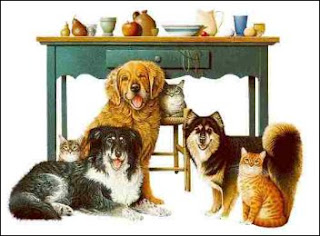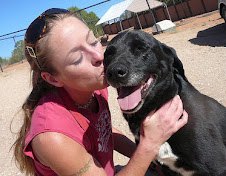
The National Research Council (NRC) has traditionally set the standard for nutrient requirements for dogs and cats with their
publications. The NRC recommends feeding trials in order to determine if a food is truly "complete and balanced". I don't have a degree in animal nutrition but that makes sense to me. How else can it be determined that a pet food is nutritionally adequate unless it is actually fed to pets over a period of time and the health of those pets monitored? The
Association of American Feed Control Officials (AAFCO) has another idea: chemical analysis.
In the early 1990's, AAFCO dropped the NRC guidelines and
established their own nutrient profiles based on the formulas of 3 generic pet foods with which they conducted feed trials. The idea being that as long as pet food manufacturers followed one of those 3 formulas, there would be no need for more feed trials. What was so wrong with the NRC requirements? To my mind, nothing. I use them myself. By disavowing the NRC standards, AAFCO could ignore the very expensive recommendation for feed trials and simply give a Nutritional Adequacy stamp to any food which passed their chemical analysis.
Again, I'm a layman but does chemical analysis tell us how biologically available any nutrients are for pets? Or how digestible they are? I don't see how that information could be determined in the absence of feed trials. For example, chemical analysis tells us that cereals, the main ingredient in most pet foods, have many nutrients. It does not tell us however that pets are unable to fully utilize the nutrients in cereals. These nutrients are biologically unavailable to pets. And since cereals make up the main part of commercial diets, it is at best misleading for AAFCO to label these foods as "complete and balanced".
AAFCO Speaks for ThemselvesFrom AAFCO's website
Q & A:
Regarding the use of downer cattle and other such animals in pet food, AAFCO says meat by-products may include "materials from animals which died by means other than slaughter" - which I interpret as animals who may have been too sick and/or diseased to survive the trip to the slaughterhouse - and are ok for use in pet food as long as the materials have been rendered according to "regulations to destroy any potential microorganisms". In other words, AAFCO says your pet food may contain bits and bobs from animals suffering from cancer, BSE (Mad Cow Disease), or any other unknown lethal illness or condition. And the carcass from said animal may have been rendered some days after the animal actually died.
Yum.
Regarding the wholesomeness of pet food ingredients, AAFCO subtly reminds consumers that it's "Buyer beware" out there, stating that even though a food is AAFCO certified as complete and balanced, "the specific nutrients may be assembled from a variety of ingredients. If consumers have a preference for certain ingredients, they should review the ingredient list to
determine if their preferences are being met." In other words, if you don't study the ingredients list on every bag or can of pet food you purchase, don't blame AAFCO if it turns out you're feeding your pet icky stuff.
Tip: The healthful looking whole foods often pictured on the front of the bag or in the television commercials do not necessarily represent the ingredients used to manufacture the food inside the bag.I'm leaving this question and answer intact as I think it illustrates the double speak and spin AAFCO seems to be so fond of:
7. Does most of the protein come from scrap and byproducts left over from human meat processing?
The animal proteins used in feeds are frequently, but not exclusively derived from the production of human food.
Couldn't they simply have answered
YES?
In summary, is the AAFCO Nutritional Adequacy statement on a pet food label actually worth anything? "The nutritional adequacy statement, the ingredient list and feeding directions will provide the consumer with the best estimate of the nutritional value and correct use of the product." Yes, you read that right:
best estimate. As we saw over and again during the massive pet food recall of 2007, companies don't actually
know what ingredients are in their pet foods. The ingredients list on the label, which AAFCO tells us it's our job to study, is just an estimate. To my mind, AAFCO's position is: It's your responsibility as a pet owner to know the ingredients of the food you feed to your pets. And you can't really know the ingredients because what's listed on the pet food label is only an "estimate" of what was actually used to make the food. So good luck and don't blame us if your pet develops health problems and/or dies due to nutritional deficiencies and excesses, or if you just plain fed him toxic food.
From
the minutes of AAFCO's 2007 meeting as posted on their site, it is evident that AAFCO, the
Pet Food Institute (PFI), the
National Renderers Association (NRA) and other industry insiders are extremely resistant to the request of Veterinarian groups to include calorie statements on pet foods. Wouldn't calorie statements be helpful to consumers? Many people are already familiar with studying and comparing calorie statements on human food labels so it would be easy for them to transfer this knowledge to pet food labels. And it would give consumers another tool with which to compare products by revealing one more bit of information. Further, since obesity in pets is such a widespread problem, calorie statements on labels would allow consumers to more accurately calculate how much food to feed rather than relying on the currently printed vague guidelines for feeding amounts. So why are pet food industry insiders so resistant to this request? Could it possibly be related to:
The costs involved in determining caloric content?
The potential for owners to feed less of their products once they know the actual calories being fed?
The possibility that owners may abandon their previously purchased brands in favor of brands better suited to their pets' needs according to the calorie statements?
The possibility that some owners may abandon commercial pet foods in favor of a home prepared diet consisting of ingredients and calories completely determined and controlled by the owner?
Hmmm.
According to the Food and Drug Administration, "
AAFCO has no legal mandate".
Well, maybe they should.
Recommended Reading:
Home-Prepared Dog & Cat Diets - The Healthful Alternative by Donald Strombeck, DVM, PhD
Downloadable pdf pamphlet from the NRC on canine nutrient requirements
Downloadable pdf pamphlet from the NRC on feline nutrient requirements





















